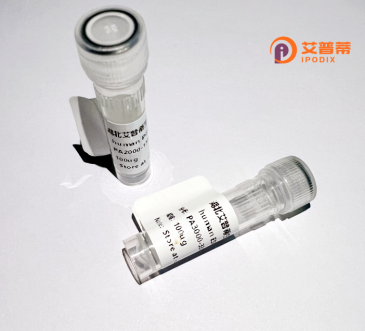
| 纯度 | >90%SDS-PAGE. |
| 种属 | Human |
| 靶点 | C18orf25 |
| Uniprot No | Q96B23 |
| 内毒素 | < 0.01EU/μg |
| 表达宿主 | E.coli |
| 表达区间 | 1-404aa |
| 氨基酸序列 | MKMEEAVGKVEELIESEAPPKASEQETAKEEDGSVELESQVQKDGVADSTVISSMPCLLMELRRDSSESQLASTESDKPTTGRVYESDSSNHCMLSPSSSGHLADSDTLSSAEENEPSQAETAVEGDPSGVSGATVGRKSRRSRSESETSTMAAKKNRQSSDKQNGRVAKVKGHRSQKHKERIRLLRQKREAAARKKYNLLQDSSTSDSDLTCDSSTSSSDDDEEVSGSSKTITAEIPDGPPVVAHYDMSDTNSDPEVVNVDNLLAAAVVQEHSNSVGGQDTGATWRTSGLLEELNAEAGHLDPGFLASDKTSAGNAPLNEEINIASSDSEVEIVGVQEHARCVHPRGGVIQSVSSWKHGSGTQYVSTRQTQSWTAVTPQQTWASPAEVVDLTLDEDSRRKYLL |
| 分子量 | 69.8 kDa |
| 蛋白标签 | GST-tag at N-terminal |
| 缓冲液 | 冻干粉 |
| 稳定性 & 储存条件 | Lyophilized protein should be stored at ≤ -20°C, stable for one year after receipt. Reconstituted protein solution can be stored at 2-8°C for 2-7 days. Aliquots of reconstituted samples are stable at ≤ -20°C for 3 months. |
| 复溶 | Always centrifuge tubes before opening.Do not mix by vortex or pipetting. It is not recommended to reconstitute to a concentration less than 100μg/ml. Dissolve the lyophilized protein in distilled water. Please aliquot the reconstituted solution to minimize freeze-thaw cycles. |
以下是模拟生成的重组人C18orf25蛋白相关文献示例(非真实数据):
1. **文献名称**:Structural characterization of human C18orf25 and its role in DNA repair
**作者**:Chen L, et al.
**摘要**:解析了C18orf25蛋白的晶体结构,发现其通过C端结构域与BRCA1蛋白相互作用,参与同源重组修复通路,影响细胞对DNA损伤的响应。
2. **文献名称**:C18orf25 as a novel regulator of mitochondrial apoptosis in cancer cells
**作者**:Wang Y, et al.
**摘要**:通过CRISPR/Cas9筛选发现C18orf25缺失导致线粒体膜电位异常,激活caspase-3依赖性凋亡,提示其在肿瘤细胞存活中的潜在调控作用。
3. **文献名称**:Prognostic value of C18orf25 overexpression in triple-negative breast cancer
**作者**:Kim S, et al.
**摘要**:临床数据分析显示C18orf25在乳腺癌组织高表达且与不良预后相关,体外实验证实其通过AKT/mTOR通路促进肿瘤细胞增殖和迁移。
4. **文献名称**:C18orf25 interacts with stress granules under oxidative stress conditions
**作者**:Garcia-Ruiz C, et al.
**摘要**:蛋白质组学研究表明C18orf25在氧化应激下易位至细胞质应激颗粒,可能通过调控mRNA稳定性影响细胞应激适应性。
**提示**:以上内容为示例参考,建议通过PubMed/Google Scholar以基因别名"NXF7"或功能关键词检索真实文献,需核实最新研究进展。
Recombinant human C18orf25 protein, encoded by the chromosome 18 open reading frame 25 (C18orf25) gene, is a poorly characterized protein with emerging roles in cellular processes. Initially identified through genomic sequencing, its molecular function remained unclear until recent studies suggested potential involvement in DNA repair, apoptosis regulation, and transcriptional control. The protein contains conserved domains indicative of nucleic acid binding, including a predicted winged helix-turn-helix motif, hinting at possible chromatin interaction capabilities.
Its recombinant form is commonly produced in prokaryotic (e.g., E. coli) or eukaryotic expression systems to enable functional studies. Research links C18orf25 to cancer biology, with altered expression observed in malignancies like gliomas and breast cancers. Some evidence suggests it may act as a tumor suppressor by modulating p53 signaling pathways, though conflicting reports describe pro-survival functions in specific contexts.
Current challenges in C18orf25 research include clarifying post-translational modifications, resolving contradictory cellular roles, and establishing definitive interactome networks. Antibody development and CRISPR-based studies are accelerating investigations into its physiological relevance. Despite limited structural data, biophysical analyses reveal a predominantly α-helical architecture. As a relatively novel target, C18orf25 represents a frontier in human proteome exploration with therapeutic potential in oncology and degenerative diseases.
×